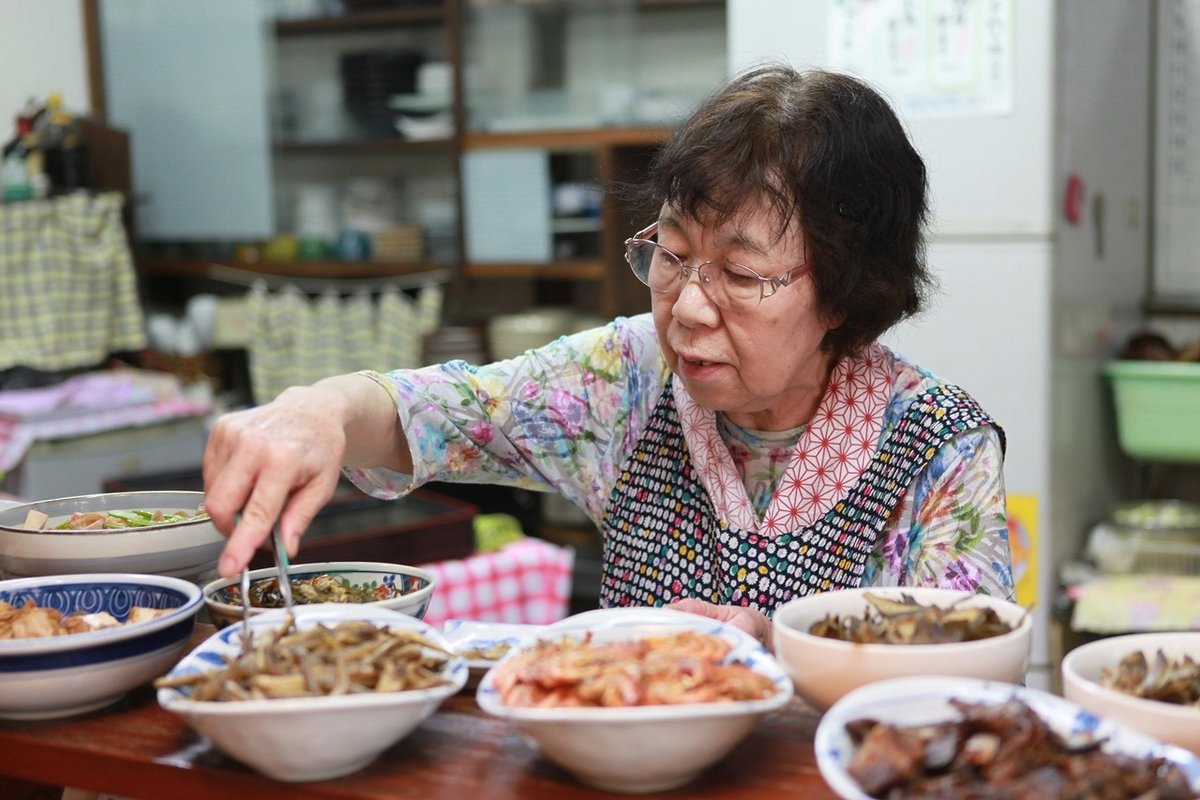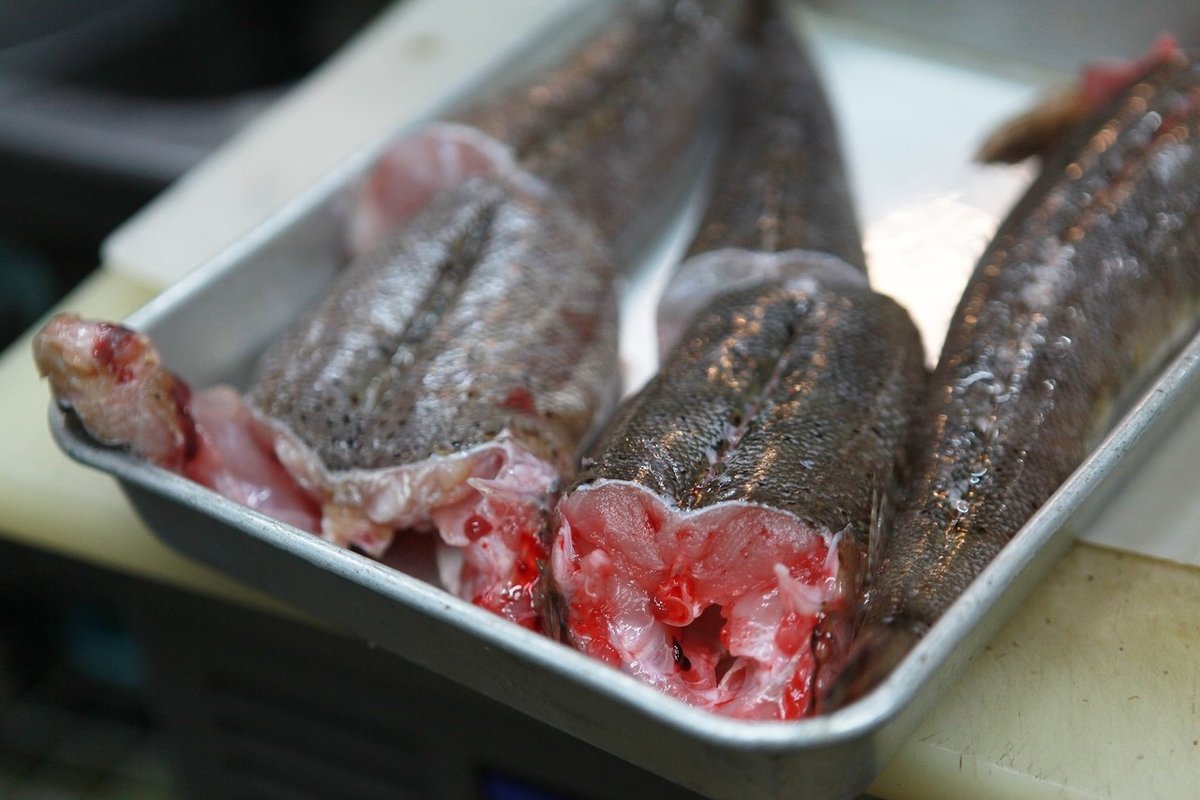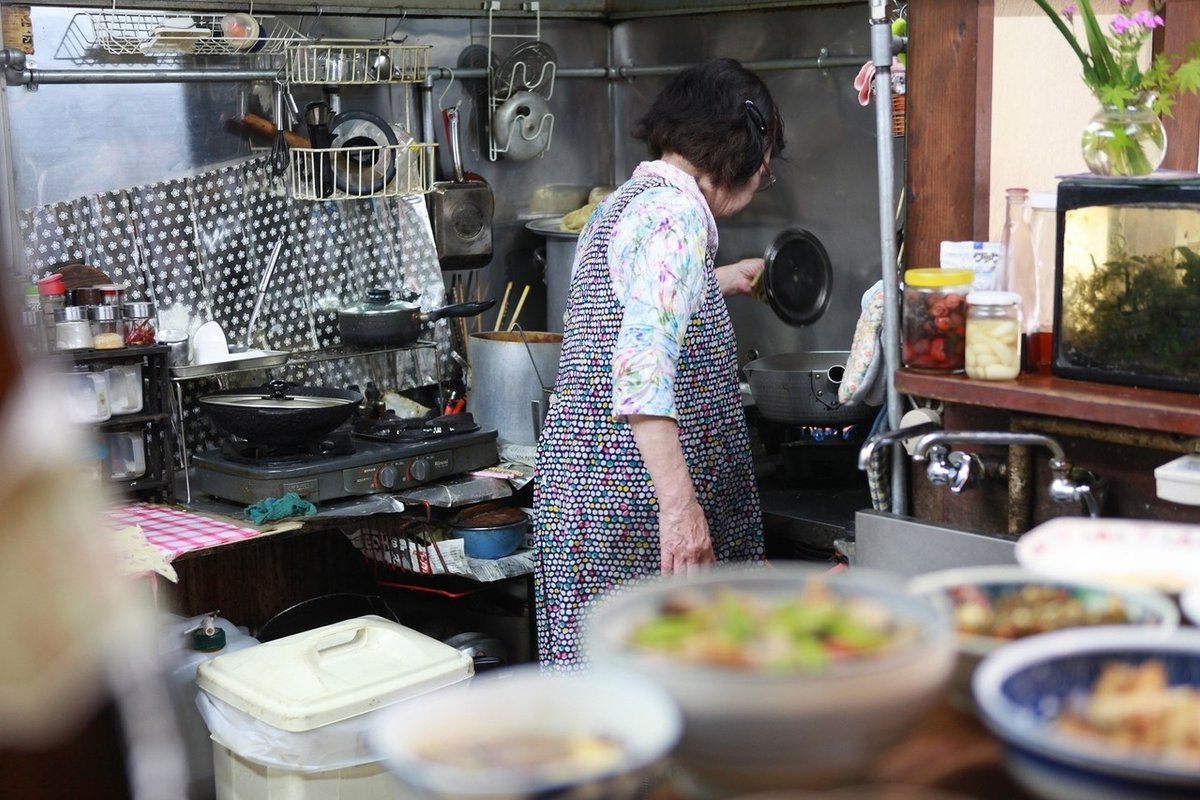
鞆の浦の睦子さんの「コチの煮付け」grandma's life recipes
「これがコチで、こっちはギギ」。鞆の浦はジブリ映画の舞台となった土地だと聞いていたから、魚の名前を聞く度に、登場人物にいたかなと考えてしまう。おもては、車2台がすれ違うのがやっとな狭い道がくねくねと続く小道ワンダーランド。港からは穏やかな潮風が吹いていて、街並みは江戸時代から続く美しい世界。福山からバスで30分ほどのこの鞆の浦の町には、「旅で会えたら」と旅人たちが思う、のんびりとした地元の空気が流れている。

どうにも狭くて、ちょっと不便そうで、それでも地元の人たちに愛されている通り(それでもこれ県道なんだって)をてくてく歩いていると、江戸時代から続くという『澤村船具店』さんの蔀戸(しみど)が開いていた。新旧入り混じる美しい船具をのぞいていると、首元にスカーフをキュッと巻いた港町に似合うハイカラなお母さんが出てきてくれた。

かつて鞆ノ浦は交易都市、瀬戸内海航路の潮待ちの港として栄え、漁業関係者がここに船具を買いにきたのだそう。通りかかった人が外から見られるようにと戸を開け、店はゆるりと営業しているようだった。「この町に、お料理好きな人はいる?」とたずねると、「このすぐそばに、『おてび』さんっていう食事処があるから。気さくなお母さんが、とっても丁寧にご飯を作られているのよ」教えてられ、さっそくお店へと向かうことにした。
「食事処 おてび」は、小さくて愛らしい佇まい。江戸後期の建物を趣そのままに残して開かれたお店だ。「大工をしている弟が外観はそのままにお店をつくってくれたの」と話す店主の睦子さんは、このまちで生まれ育った。一度は結婚で福山に出たものの、40歳の時にはこの地に戻ってきた。それ以来30年、女手ひとつで子育てをしながら店を育ててきた。地元の人にも観光客にも愛されるお店となった「おてび」の名前は、鎌倉時代にはすでに行われていたと伝えられる「お手火祭り」に由来する。

「日本三大火祭りのひとつでね、鞆を代表するような、ずっと親しんできた名前。『お店に使ってもいいですか』と沼名前神社の神主さんに聞きに言ったら、『ぜひこの名前で鞆の顔になるお店にしてくださいね』ってすぐ承諾してくださった。以来毎年、お参りや奉納は欠かしたことがないね」
このお店のメインメニューは、地元の魚たち。「なんでもない魚」と地元の人たちが言う魚たちだ。
「始めた頃は、定食屋さんによくあるようなメニューを出してたの。ほら、生姜焼きとかね。特別料理にこだわりがあったわけじゃないの。でもある日、いっつも漁のあとに集まってはずいぶん飲んで帰って行く漁師さんたちに『なんでワシらの獲った新鮮な魚があるのに使わんのや、絶対一番うまいのに』って言われてね。『確かにそうね』って、それで今の小魚定食が出来たのよ」

朝、海沿いを歩くと、漁師さんたちがその日に獲れた魚たちを並べて売る姿が見られる。まとまった市場になっているわけではなく、港沿いのちょっとしたところに自分の売り場をつくってそれぞれ売っているのだ。30分、1時間というあっという間の短い時間だ。その間に人々は港まで出てきて声を掛け合って小魚を買い求める。「鞆の人は小魚をいっぱい食べてるから元気なんよね」と睦子さんは言う(それでも最近では漁師の数も魚の数もずいぶん減ってしまったのだそう)。
ところで「なんでもない地元の魚」と言われるこの魚たちの名前が実はなかなか厄介で、地元の人はそのほとんどの種類をコチと呼ぶ。見た目が全然違うのに、どれもコチと呼ばれているのだ(私の目の前も2、3種類のコチが横切って行った)。特別な名前も価格も付かないこの魚たちは、流通に乗ることもない。さらには地元の人は「お客様に出しては悪い」と思うのか、食べられる店が意外となく、睦子さんのお店は貴重な存在になっているよう。

睦子さんが私のためにさっと作ってくれたのは、今日獲れたばかりのコチ(大)の煮付け。酒に醤油を入れて、「砂糖? 私は入れないの」と言って沸騰寸前でコチを入れて落し蓋をする。揺らさず数分煮つけると、さっぱり上品な味付けふっくらと仕上がる。そのほかにも、漁師さんたちが朝持って来てくれるというギギやコチ(小)は、必ず潮風に当てて数時間天日干ししてから揚げて味付けする。そのひと手間で、太陽の味をギュッと閉じ込め、骨も頭もまるごとぺろりと頂ける鞆の浦味になる。

睦子さんは午前中に一気に料理をする。昼になると、魚たちが大きな器に盛られてカウンターにずらりと並び、圧巻だ。小魚が多いのがこの土地の特徴だろう、こんなにたくさんの種類の小魚が新鮮なまま一度に並ぶのを見たことはない。干物だって干す時に新鮮であるほど格段に美味しさを増すはず。
睦子さんが味付けをした鞆ノ浦の魚を食べると、昼間からビールをぐびっといきたくなる。夕方の開店と同時に、毎日1杯だけここに飲みに来るというお客さんがやって来る。そして、なんでもない話をして、「また明日」と言って帰って行く。

「この家の中庭には150歳になるイチョウの木があって、秋になるとね、たわわに実をつけるの。常連さんはみんなそれを知ってるから、『そろそろあの匂いがするな〜』なんて言うのよ。困っちゃうのよ」と、睦子さん困り顔で言いながら、毎年せっせと処理をしては、銀杏を出している。お客さんたちにとっては、この季節になると出てくる楽しみなのだ(しかも無料)。
「昔はね、大人も子どもも一緒になって遊びまわってた。今よりもっと綺麗だった海に飛び込んで、ほんとに楽しかった。この歳になっても月に一度は地元の同級生たちと集まって、年に2回は一緒に旅行に行くほど仲がいいの。私は今も昔も、すぐそばに居る人に声を掛け合って暮らせるこの町が好き」と睦子さんは笑う。同級生ひとり残らず電話して人を集めるのは睦子さんの役目で、「必ず全員に声をかけるの」と言う。そんな睦子さんは、お客さんの好みもすぐに覚え、次に来た時にはさらっと好きな料理を出してあげる心遣いだって欠かさない。今では、その地元らしい料理を求めて、外国人観光客も訪ねてくる。
「ここの料理は私が考えたんじゃないの。漁師さんたちに言われたようにしただけ」
おいしい魚が鞆ノ浦にはある。睦子さんは、それを「なんでもない魚」と呼びながら、今日も明日も料理する。
【ばあちゃん訪問】
中村 優(なかむら・ゆう)
タイ・バンコク在住の台所研究家。『40creations』代表。大学時代にさまざまな国をまわる中で「食は国境や世代を超えて人々を笑顔にする」ことを実感。2012年、世界各国の地域からの「とびきりおいしい」をおすそ分けするサービス『YOU BOX』スタートと同時に、世界中のばあちゃんのレシピ収集を開始。3年間で15カ国の100人以上のばあちゃんたちと台所で料理しながら会話し、彼女たちの幸せ哲学を書き上げた『ばあちゃんの幸せレシピ』(木楽舎)著者。2018年、タイにてTASTE HUNTERSを現地パートナーとともに立ち上げる。
瀬戸内への旅の玄関口
福山駅前のまちやど「AREA INN FUSHIMICHO FUKUYAMA CASTLE SIDE」
●公式Webサイト
住所:伏見町4-33 FUJIMOTO BLDG. 1F(RECEPTION)
AREA INN FUSHIMICHOは、まち全体をひとつの「宿」と見立てた「まちやど」です。泊まる、食べる、くつろぐ、学ぶ、遊ぶ、さまざまな要素がまちのなかに散りばめられています。チェックインを済ませたら、伏見町、そして福山のまちから瀬戸内への旅へ。
この記事が気に入ったらサポートをしてみませんか?
